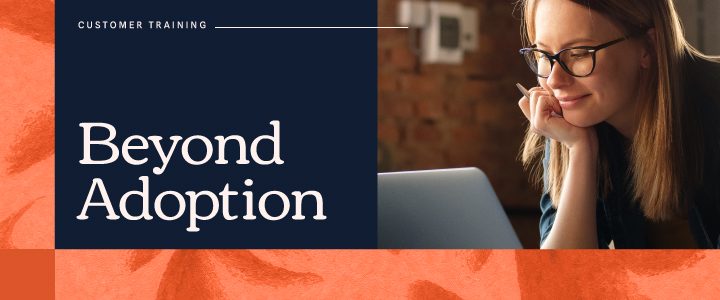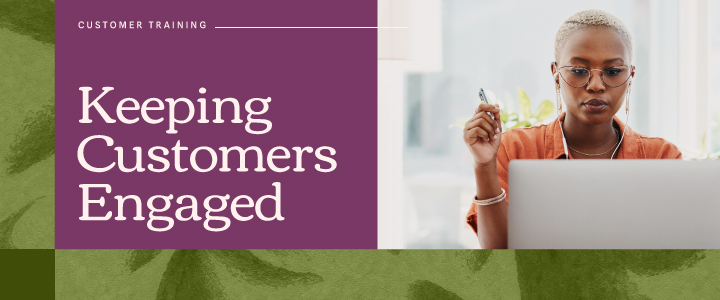
7 min reading time
The Role of Customer Education in the Lifecycle: How Learning Drives Growth at Every Stage
What you’ll learn:
- Customer education isn’t just for onboarding—it drives value and growth across the entire customer lifecycle.
- Customer education is becoming a priority investment—nearly 9 in 10 organizations already see direct ROI.
- At each stage, education has a role: Attract (build trust), Activate (accelerate value), Engage (boost adoption/retention), Grow (expand revenue & advocacy).
- When aligned to the lifecycle, a customer academy becomes a true growth engine — strengthening relationships, satisfaction, and long-term revenue.
What’s the first thing that comes to mind when you think about customer education? Setup tutorials, some product walkthroughs, maybe a guided onboarding learning path?
That’s definitely part of it, but the spectrum of customer education is much more comprehensive. It doesn’t just support onboarding—it drives value, engagement, and growth at every stage of the customer lifecycle. From building trust with prospects before they buy, to creating super users who become advocates for your product, education plays a strategic role across the full journey—not just post-sale.
In fact, 93% of organisations said their investment in customer education has increased in the last year, with 33% reporting a significant increase. This reflects the growing recognition that education is a core growth driver.
So, let’s explore the role of education in the customer lifecycle. At LearnUpon we’ve created a four-stage framework that matches education efforts to the full customer journey: Attract, Activate, Engage, and Grow. By breaking down how learning can make a difference in each stage—and how companies can use it to drive measurable growth—it becomes clear how you can use customer education as more than just a support function, and turn it into a powerful growth engine for your business.
What Role Does Customer Education Play in the Customer Lifecycle?
So, how does education fit into the customer lifecycle—and why should you care?
When customers know how to get value from your product quickly and consistently, they stick around longer, engage more deeply, and become your biggest advocates. This is reflected in data as 89% of organizations say they’ve seen a direct ROI from their customer education efforts—proof that education is more than just helpful; it’s profitable.
By equipping both prospects and customers with the knowledge to accelerate and maximize value, education becomes a powerful driver of engagement, satisfaction, and growth.
Starting with the Attract stage. This is where customer education does exactly what it sounds like: attracts potential new customers by sharing expertise, building trust, and guiding informed decisions.
Next comes the post-sales phase, Activate, where education shifts from attracting prospects to empowering the now customers. Here, customer education ensures a smooth setup and helps new customers reach product value faster.
The next challenge? Keeping customers hooked. This is where the Engage stage comes in. The goal is to create valuable experiences that strengthen customer relationships.
And lastly, Grow. This phase focuses on turning engaged customers into super users who not only drive revenue, but also engage in advocacy. It’s about expanding the use of your product and creating champions who promote your brand—fueling long-term growth and loyalty.
The Power of Customer Learning at Every Stage
As we’ve seen, each stage of the customer lifecycle calls for a specific educational approach. When done right, these learning experiences not only deliver value in the moment, but also prepare customers for the next stage, where fresh strategies take over. And it all begins with Attract.
Attract
The focus here is awareness and acquisition, making Marketing and Sales teams key stakeholders. In fact, education has always played a role in both these departments. Think top-of-funnel content, such as webinars, eBooks, and blog posts. But today, we’re seeing public facing customer academies become powerful ways to attract and convert prospects.
The biggest, most successful example of this? HubSpot. HubSpot Academy has become one of the most famous customer academies in the world. By offering free certifications and world-class educational content, HubSpot turned learning into a juggernaut marketing engine. And it’s resulted in massive brand recognition and awareness on a global scale. Not only that, HubSpot Academy is also a lead generation powerhouse—its number one source, driving more leads for HubSpot than any other channel.
As you can see, this top-of-funnel educational content don’t just inform—it empowers your customers through learning, helps amplify brand recognition, establish credibility, and give buyers the confidence to move forward with your solution. By positioning your brand as a trusted expert, you help buyers make better decisions (and hopefully sign a new deal).
Examples of Attract-stage Education
- Educational webinars with clear takeaways, showcasing industry expertise
- Free certifications that allow your prospects to get to know your product better
- Open academies & free mini-courses that help you establish brand authority
- Interactive tools (assessments, quizzes, knowledge checks) help surface early lead signals
When prospects engage with your educational experiences during their decision-making process, it shortens the sales cycle by answering many of their questions upfront. Informed prospects lead to higher conversion rates—meaning your team can spend less time closing individual deals and more time driving overall growth, ultimately boosting your revenue.
Indeed, 31% of organisations anticipate future growth in customer education because of lead generation through courses—highlighting the importance of Attract-stage education in fuelling the top-of-funnel.
Activate
The most well-known stage of the customer education lifecycle, Activate aims to help new customers master your product quickly through timely, onboarding-focused content. The goal is to fuel early momentum with best-practice learning that builds confidence and satisfaction.
Examples of Activate-stage Education
- Onboarding learning paths tailored by role or use case
- In-app tutorials or embedded course content
- “Getting started” courses — and anything that helps your customers ramp up efficiently
A successfully activated customer relies less on Customer Support, reducing support tickets over time and freeing up your team to focus on higher-value tasks. The customers see product value faster, which lowers churn and drives long-term retention.
Engage
You’ve attracted and activated your customers—but customer education’s role doesn’t stop there. Now, the focus is on keeping customers engaged to deepen adoption and prevent drop-off. At this stage, your priority is to empower customers with the right resources at the right time to boost retention.
This means reducing friction through self-serve learning and continuously reinforcing product value with targeted education. The key is to use customer behavior data to understand their needs and deliver timely, relevant education that benefits both customers and your team.
Examples of Engage-stage Education
- Just-in-time learning triggered by product usage
- On-demand training and ongoing skill-building modules
- Role-based or vertical-specific training refreshers
Companies investing in Engage-stage education reap rewards like increased product adoption, higher customer satisfaction (improving NPS and CSAT), enhanced customer proficiency, and lower churn risk.
This is backed by statistics showing that 47% of organizations say customer satisfaction is the primary goal of their customer education program, and 41% prioritize customer retention. Moreover, 90% of organizations report customer satisfaction scores impact their business.
Grow
By this point, customers have successfully adopted and engaged with your solution—and now it’s time to expand their relationship, drive renewal, and unlock new revenue opportunities. At this stage, customer education helps deepen expertise, encourage exploration of advanced features, and potentially scale usage within their organization.
By delivering targeted and ongoing learning experiences, you empower customers—making them feel capable, satisfied, and proud to become advocates for your brand.
Examples of Grow-stage Education
- Advanced certifications and learning paths
- Training for new product lines or features to encourage cross-sell
- Alumni or champion programs linked to education milestones
How can you tell if you’re succeeding at the Grow stage? You’ll see customers expanding their usage, renewing their contracts consistently, and becoming enthusiastic advocates—all supported by ongoing education that deepens their expertise and commitment.
How to Build a Lifecycle-Aligned Customer Academy
Understanding the customer lifecycle is one thing—putting it into practice is where the magic happens. To make the most of customer education across the lifecycle, you need a thoughtful strategy that connects learning directly to where your customers are in their journey. Here’s how to get started with a customer academy built for impact and scale:
Map Education to Each Lifecycle Stage
Ensure your content is relevant, timely and impactful by tailoring it to address the unique needs of prospects and customers at Attract, Activate, Engage and Grow. One-size-fits-all is no longer in your customer education vocabulary.
Connect Your Tools for Seamless Learning
Make your life easier by automating content delivery and tracking to provide a seamless learning experience and reduce manual work. Think CRM platforms like HubSpot, LMS solutions, like LearnUpon, and SSO. Anything that can take the load off your team!
Make Learning Flexible, Scalable, and Personal
Your content is created—and great news, it’s effective! But how much support does your team still need to provide for customers to truly benefit from it? Empower your customers to learn at their own pace with flexible, on-demand content that scales effortlessly. Personalization ensures every learner gets exactly what they need, boosting engagement.
Use Data to Prove and Improve Your Customer Education
Ensuring your customer education efforts are data-driven and measurable is key to demonstrating their impact and driving continuous enhancement. After all, you can’t improve what you don’t measure! Defining clear, measurable goals tied to each stage of the customer lifecycle is essential to keep your learning outcomes on track.
Key metrics to focus on at each lifecycle stage:
- Attract: Lead conversion rate, marketing-qualified leads (MQLs), sales cycle length
- Activate: Time-to-value, onboarding completion rate, reduction in support tickets, early product adoption metrics
- Engage: Retention rate, customer satisfaction scores (NPS, CSAT), active user rate, course completion rates, feature adoption rate
- Grow: Expansion revenue, upsell/cross-sell conversions, customer advocacy and referral rate
Collect data from multiple sources, such as customer academy reports, CRM activity, customer feedback, support tickets, and product usage analytics to get a comprehensive view of performance. Complement quantitative data with qualitative insights through feedback loops and surveys to uncover learning gaps or friction points where customers may struggle or disengage.
Track learner progress and engagement rates to understand how your content impacts behavior. Look beyond the surface and analyze correlations between education engagement and key business outcomes, such as reduced churn, increased adoption, or higher NPS scores. These insights are valuable assets to continuously review, iterate, and optimize your content for maximum effectiveness.
Closing the Loop on Customer Education
Customer education isn’t just a support function—it’s a powerful growth driver. Understanding its role at every stage of the customer lifecycle is essential to unlock its full long-term revenue-generating potential.
When designed for the entire lifecycle, it becomes a consistent driver of value—strengthening relationships, deepening engagement, and sustaining growth long after onboarding is complete.



